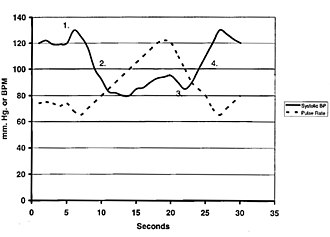Valsalva maneuver
A breathing technique used to equalize pressure in the ears and chest

Valsalva maneuver[edit]
The Valsalva maneuver is a breathing technique that involves attempting to exhale with the nostrils and mouth, or the glottis, closed. This maneuver is named after Antonio Maria Valsalva, an Italian physician who first described it in the 17th century. It is commonly used to equalize pressure in the middle ear and sinuses, and is also employed in various medical tests and procedures.

Mechanism[edit]
The Valsalva maneuver involves a forced expiration against a closed airway. This is typically achieved by closing the mouth and pinching the nose shut while attempting to exhale forcefully. The maneuver increases pressure in the thoracic cavity, which can affect the cardiovascular system and autonomic nervous system.

Uses[edit]
The Valsalva maneuver is used in several contexts:
- Equalizing ear pressure: It is commonly used by scuba divers, aviators, and individuals experiencing rapid altitude changes to equalize pressure in the middle ear.
- Medical testing: The maneuver is used in cardiology to assess heart function and diagnose certain heart conditions. It can also be used to test the function of the autonomic nervous system.
- Childbirth: The maneuver is sometimes used during the second stage of labor to assist with pushing.
Risks and contraindications[edit]
While generally safe, the Valsalva maneuver can have risks, particularly for individuals with certain medical conditions. It can lead to a temporary decrease in venous return to the heart, which may cause a drop in blood pressure and heart rate. People with cardiovascular disease or glaucoma should consult a healthcare professional before performing the maneuver.
History[edit]
The maneuver is named after Antonio Maria Valsalva, who described it in his 1704 publication on the anatomy of the human ear. Valsalva originally described the technique as a way to clear pus from the middle ear.
Related pages[edit]
-
Valsalva maneuver
-
Valsalva maneuver
-
Samantha Cristoforetti demonstrating Valsalva device
Ad. Transform your life with W8MD's Budget GLP-1 injections from $75


W8MD offers a medical weight loss program to lose weight in Philadelphia. Our physician-supervised medical weight loss provides:
- Weight loss injections in NYC (generic and brand names):
- Zepbound / Mounjaro, Wegovy / Ozempic, Saxenda
- Most insurances accepted or discounted self-pay rates. We will obtain insurance prior authorizations if needed.
- Generic GLP1 weight loss injections from $75 for the starting dose.
- Also offer prescription weight loss medications including Phentermine, Qsymia, Diethylpropion, Contrave etc.
NYC weight loss doctor appointmentsNYC weight loss doctor appointments
Start your NYC weight loss journey today at our NYC medical weight loss and Philadelphia medical weight loss clinics.
- Call 718-946-5500 to lose weight in NYC or for medical weight loss in Philadelphia 215-676-2334.
- Tags:NYC medical weight loss, Philadelphia lose weight Zepbound NYC, Budget GLP1 weight loss injections, Wegovy Philadelphia, Wegovy NYC, Philadelphia medical weight loss, Brookly weight loss and Wegovy NYC
|
WikiMD's Wellness Encyclopedia |
| Let Food Be Thy Medicine Medicine Thy Food - Hippocrates |
Medical Disclaimer: WikiMD is not a substitute for professional medical advice. The information on WikiMD is provided as an information resource only, may be incorrect, outdated or misleading, and is not to be used or relied on for any diagnostic or treatment purposes. Please consult your health care provider before making any healthcare decisions or for guidance about a specific medical condition. WikiMD expressly disclaims responsibility, and shall have no liability, for any damages, loss, injury, or liability whatsoever suffered as a result of your reliance on the information contained in this site. By visiting this site you agree to the foregoing terms and conditions, which may from time to time be changed or supplemented by WikiMD. If you do not agree to the foregoing terms and conditions, you should not enter or use this site. See full disclaimer.
Credits:Most images are courtesy of Wikimedia commons, and templates, categories Wikipedia, licensed under CC BY SA or similar.
Translate this page: - East Asian
中文,
日本,
한국어,
South Asian
हिन्दी,
தமிழ்,
తెలుగు,
Urdu,
ಕನ್ನಡ,
Southeast Asian
Indonesian,
Vietnamese,
Thai,
မြန်မာဘာသာ,
বাংলা
European
español,
Deutsch,
français,
Greek,
português do Brasil,
polski,
română,
русский,
Nederlands,
norsk,
svenska,
suomi,
Italian
Middle Eastern & African
عربى,
Turkish,
Persian,
Hebrew,
Afrikaans,
isiZulu,
Kiswahili,
Other
Bulgarian,
Hungarian,
Czech,
Swedish,
മലയാളം,
मराठी,
ਪੰਜਾਬੀ,
ગુજરાતી,
Portuguese,
Ukrainian


